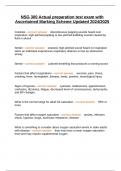NSG 300 Actual preparation test exam with
Ascertained Marking Scheme Updated 2024/2025
Crackles - correct answer discontinuous popping sounds heard over
inspiration; high-pitched popping or low-pitched bubbling sounds caused by
fluid in alveoli
Stridor - correct answer strained, high-pitched sound heard on inspiration
when an individual experiences respiratory distress or has an obstructed
airway
Stertor - correct answer Labored breathing that produces a snoring sound
Factors that affect respirations - correct answer exercise, pain, stress,
smoking, fever, hemoglobin, disease, meds, position, neurological injury
Signs of hypoxia - correct answer cyanosis, restlessness, apprehension,
confusion, dizziness, fatigue, decreased level of consciousness, tachycardia,
and BP changes
What is the normal range for adult O2 saturation - correct answer 95% or
more
Factors that affect oxygen saturation - correct answer anxiety, infection,
shock, hypoxia, drugs, acid-base imbalance, disease
What is something to consider about oxygen saturation levels in older adults
with disease - correct answer they may have a lower oxygen saturation
level and may require supplemental oxygen
,Disease definition - correct answer Infection is the invasion of a susceptible
host by pathogens or microorganisms. Infection will develop if the Chain of
Infection stays intact. This infection will ultimately result in disease.
Chain of infection - correct answer -infectious agent/pathogen
-reservoir: place where microorganism survives, multiplies, and waits to be
transferred to a susceptible host.
-portal of exit
-mode of transmission
-susceptible host
Acute disease - correct answer fast onset, severe/abrupt symptoms,
reversible
Chronic disease - correct answer slow onset, never goes away, persists 6
months or longer
HAI - correct answer an infection that develops in a person cared for in any
setting where health care in given. The infection is related to receiving health
care
Iatrogenic HAI - correct answer from a procedure
Exogenous HAI - correct answer from microorganisms outside the
individual (Salmonella)
Endogenous HAI - correct answer when patient's normal flora becomes
altered (C.diff)
Body's response to stress - correct answer Basal metabolic rate increases
as the body uses energy stores. Adrenocorticotropic hormone increases
,serum glucose levels and decreases anti-inflammatory responses. If this lasts
a while, it can cause decreased resistance to infection.
Inflammation - correct answer protective vascular and cellular reaction to
eliminate pathogens and necrotic tissues.
Serous exudate - correct answer Watery exudate: indicates early
inflammation
Sanguinous exudate - correct answer bloody
Purulent exudate - correct answer Pus: indicates a bacterial infection
(made up of bacteria, neutrophils, monocytes, and wbcs)
Signs of inflammation - correct answer redness, heat, swelling, pain,
tenderness, loss of function, increased wbcs
Localized infection - correct answer infection limited to a specific part of the
body; has local symptoms
Systemic infection - correct answer infection spreads to several sites and
tissue fluids usually in the bloodstream
How can you ensure quality and safety in client care - correct answer
Apply standard precautions, use clean gloves, use proper PPE, keep bedside
tables clean, clean all equipment, ensure patient is covers nose and mouth
when coughing and/or sneezing
Mode of transmission: airborne - correct answer carried in droplet nuclei,
need to wear N95, special equipped room with negative air flow
, Mode of transmission: droplet - correct answer sneeze or cough creates
droplets carrying germs short distances, wear a surgical mask within 3 feet,
proper hand hygiene, some dedicated-care equipment
Mode of transmission: direct contact - correct answer requires gowns and
gloves; ex. Staphylococcus aureus, rhinovirus
Mode of transmission: indirect contact - correct answer involves contact
with contaminated inanimate objects (needles, utensils, hospital equipment,
etc)
Mode of transmission: vehicle - correct answer contaminated items such
as water, drugs, solutions, blood, food
Mode of transmission: vector - correct answer transmission from parasites
such as mosquitos, louse, flea, tick
Importance of safety in client based care - correct answer -patient centered
care: center the patient's care on their beliefs, values, etc.
-teamwork/collaboration: shared decision making for quality care
-evidence based practice: include current evidence with clinical skills
-quality improvement: use data to monitor patient outcome and use methods
to test changes
-safety: minimize risk of harm by following safety precautions
Vulnerable populations - correct answer individuals with limited access to
health care, those who depend on others for care, those with low social
support, those with limited financial clearance
Standard precautions for infection control - correct answer -hand hygiene
-educate about infection prevention




